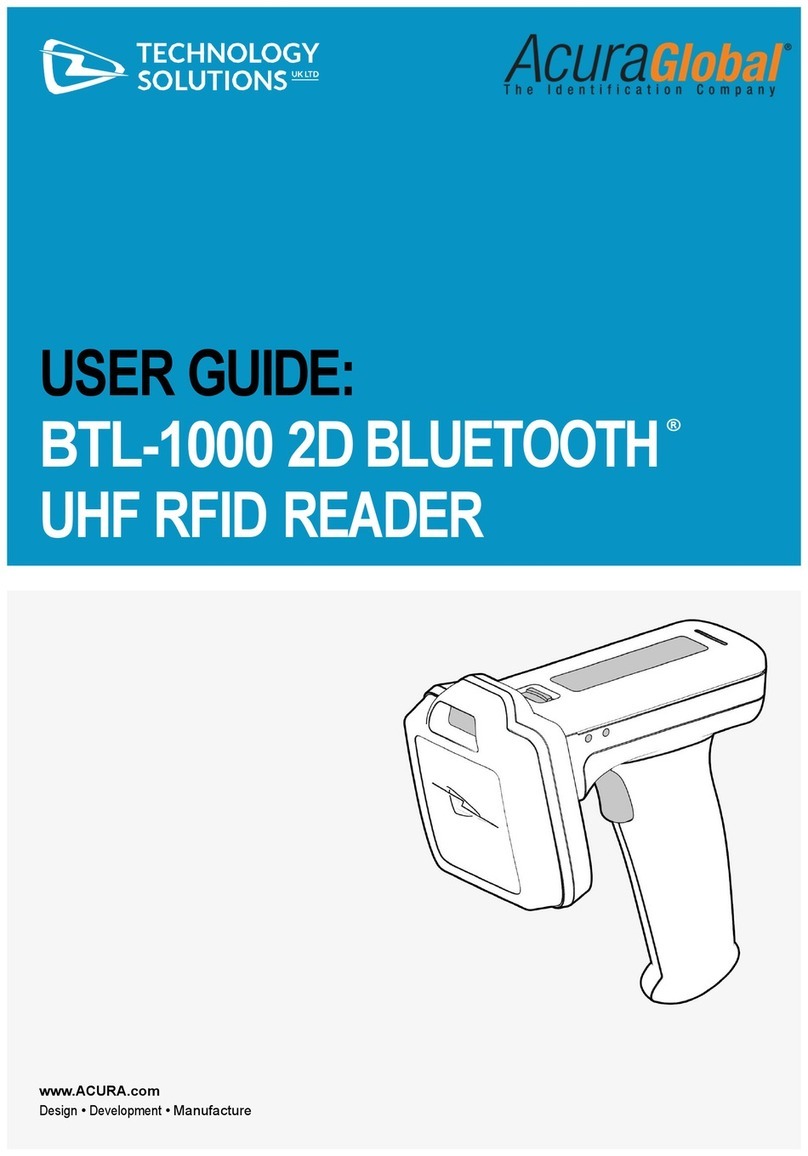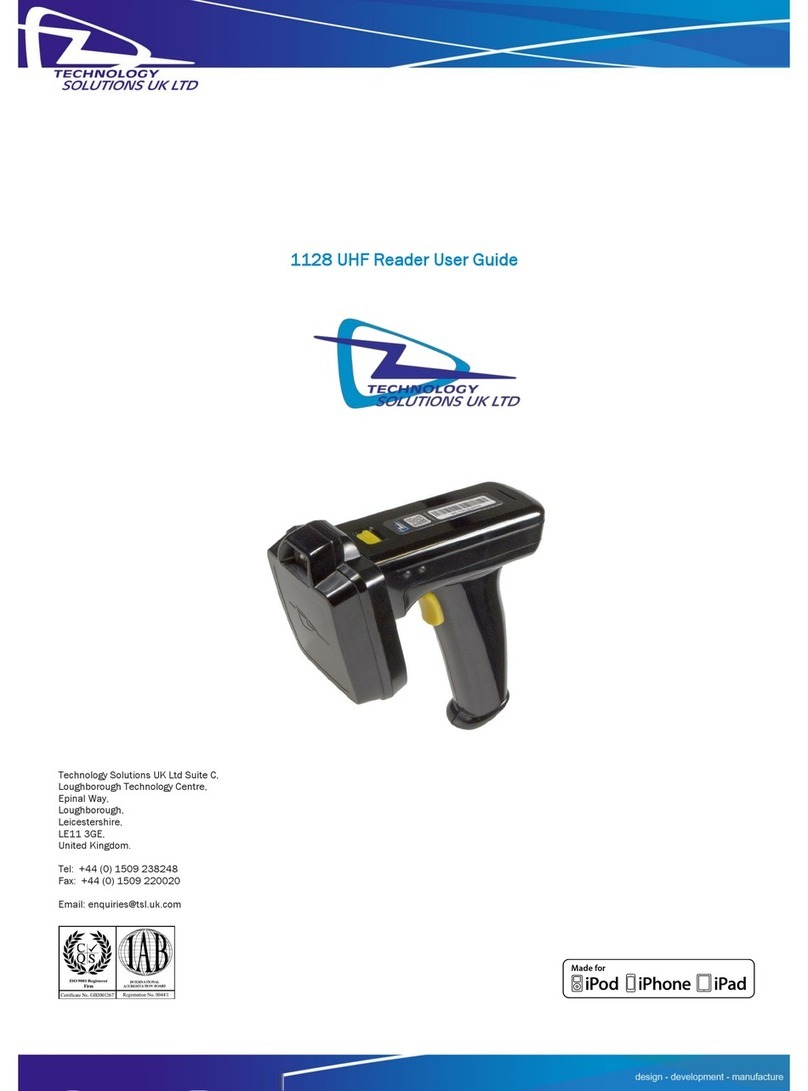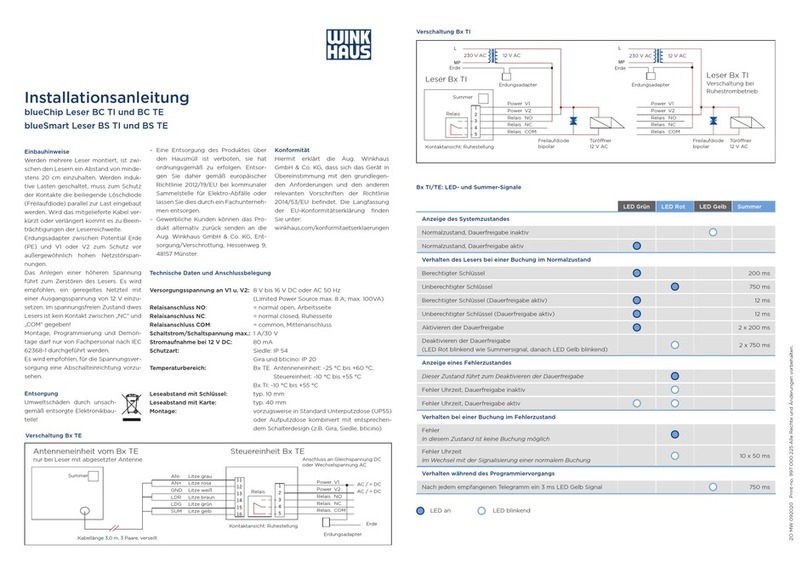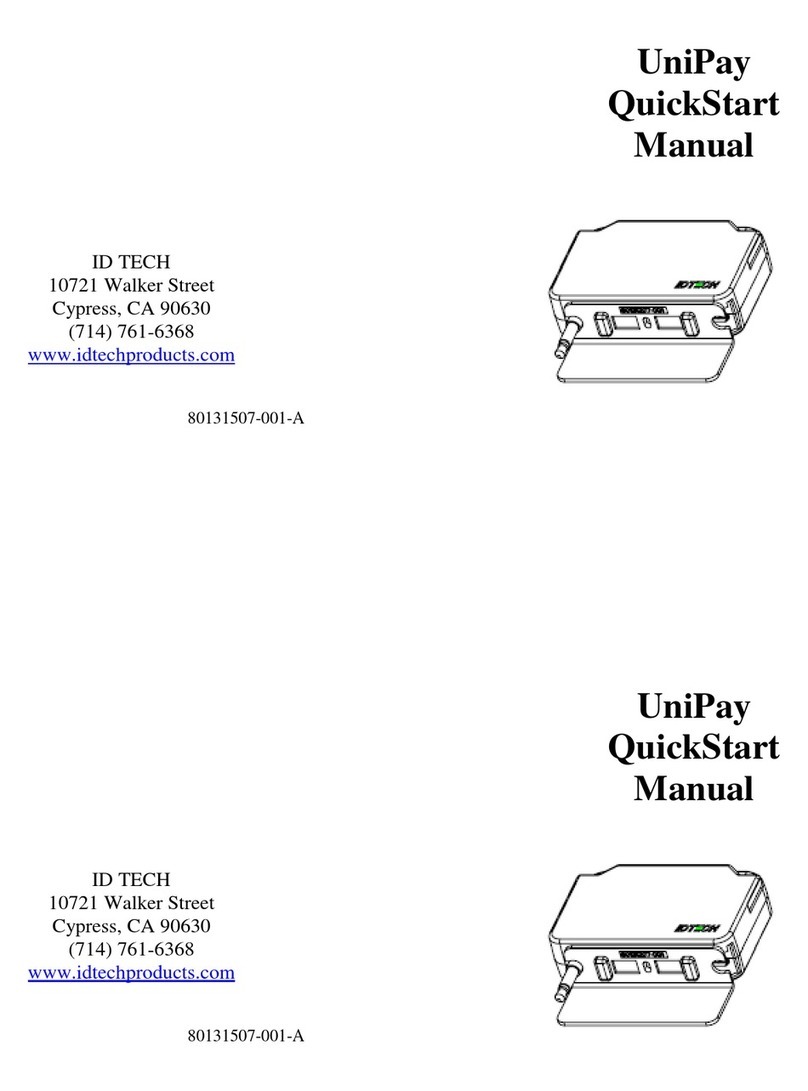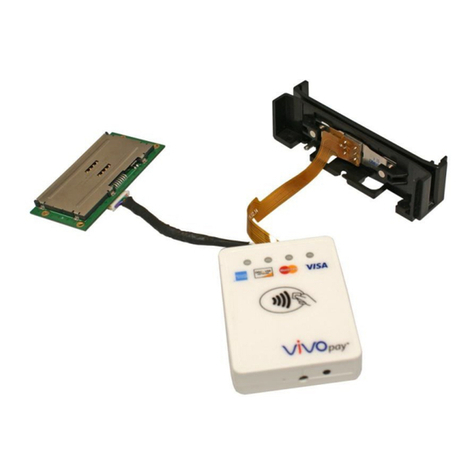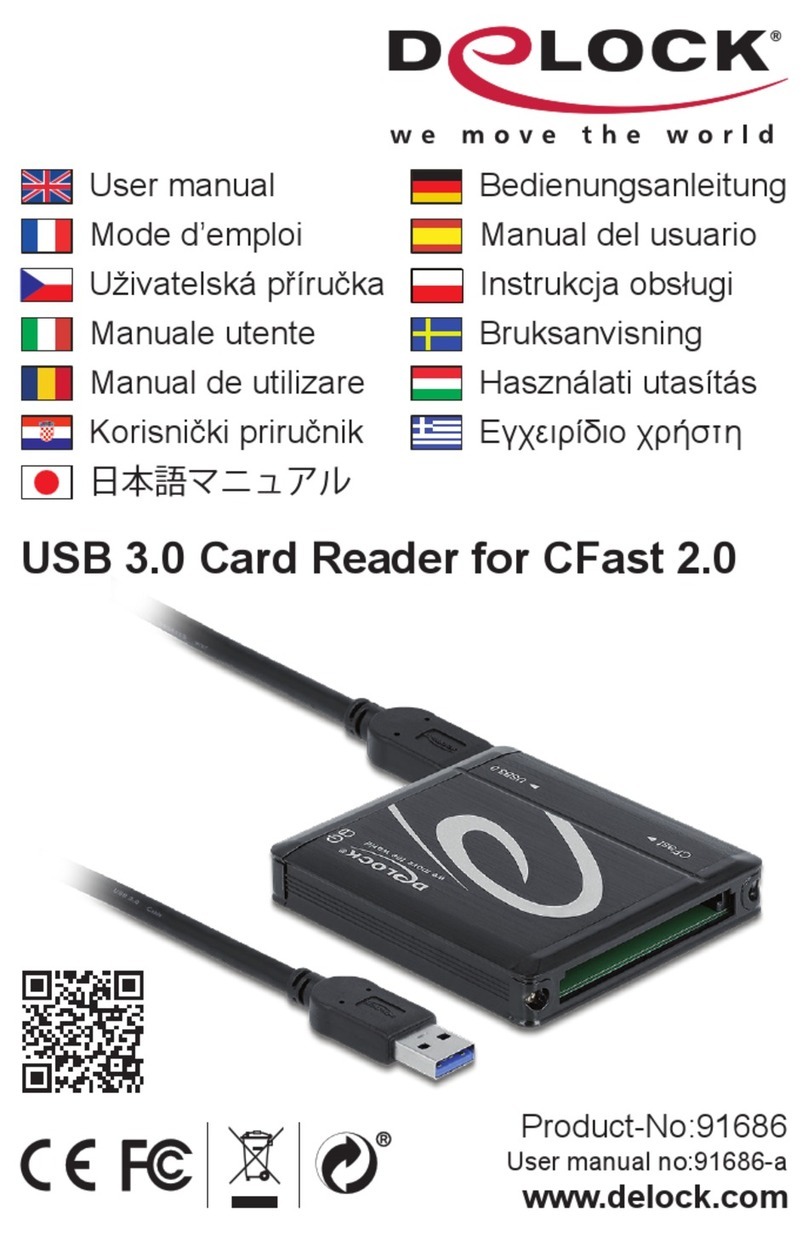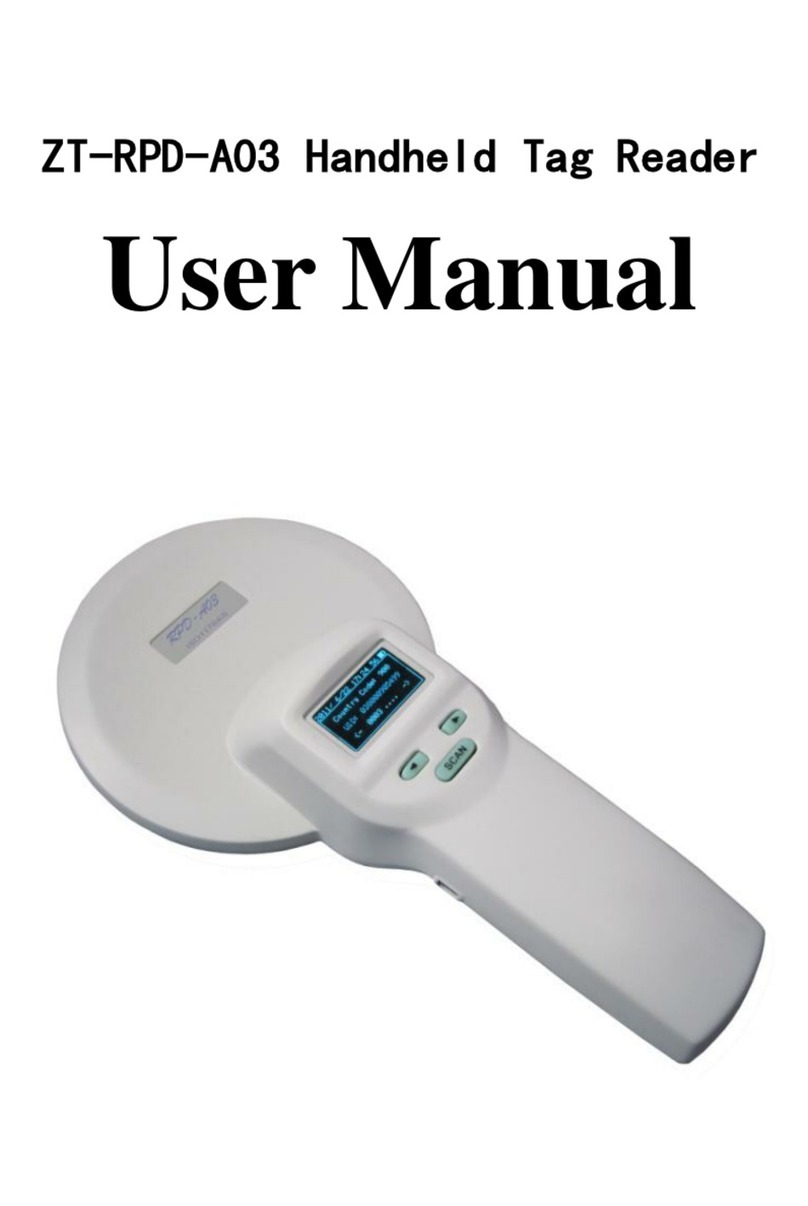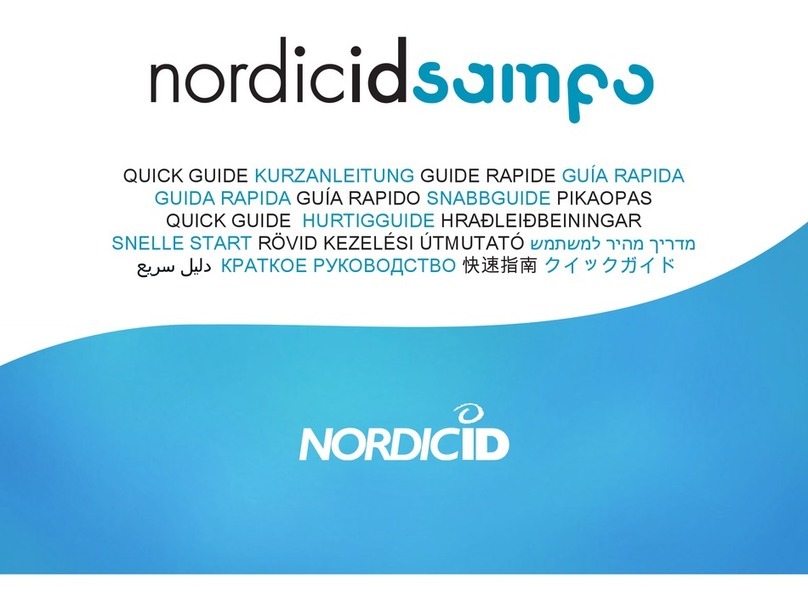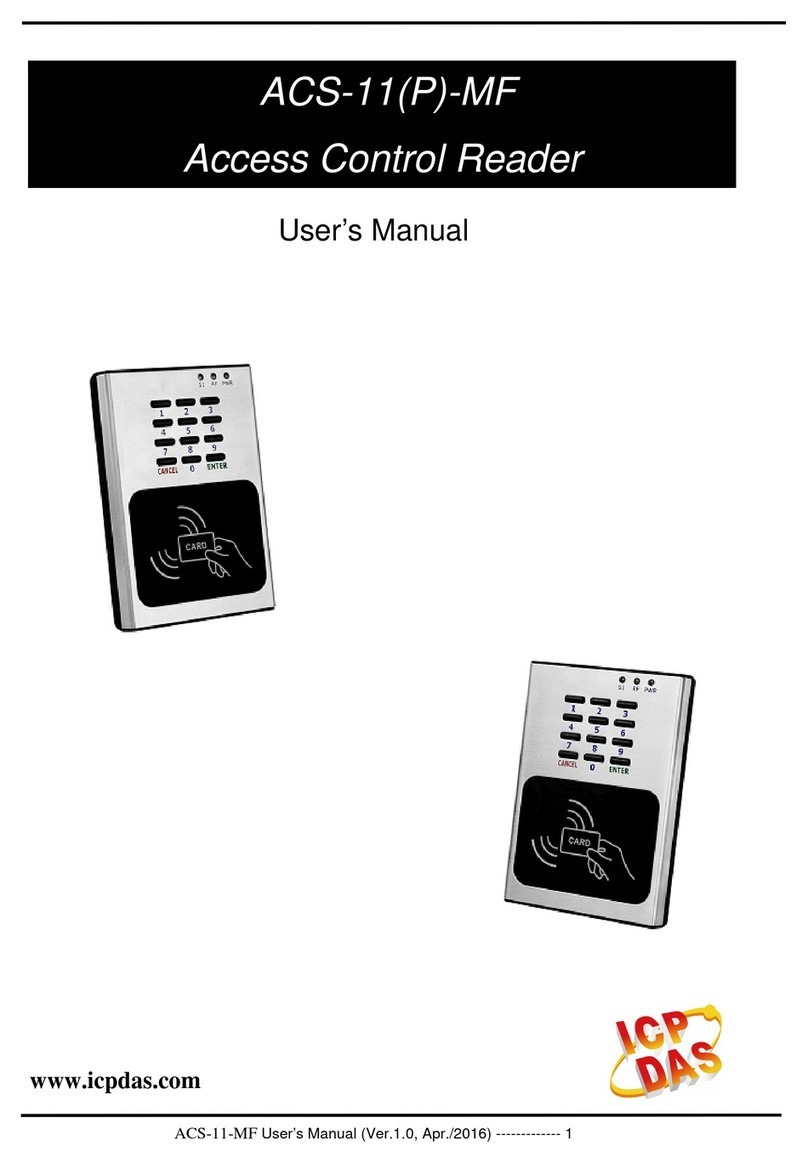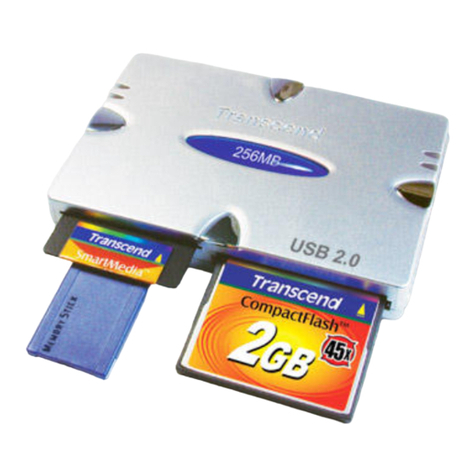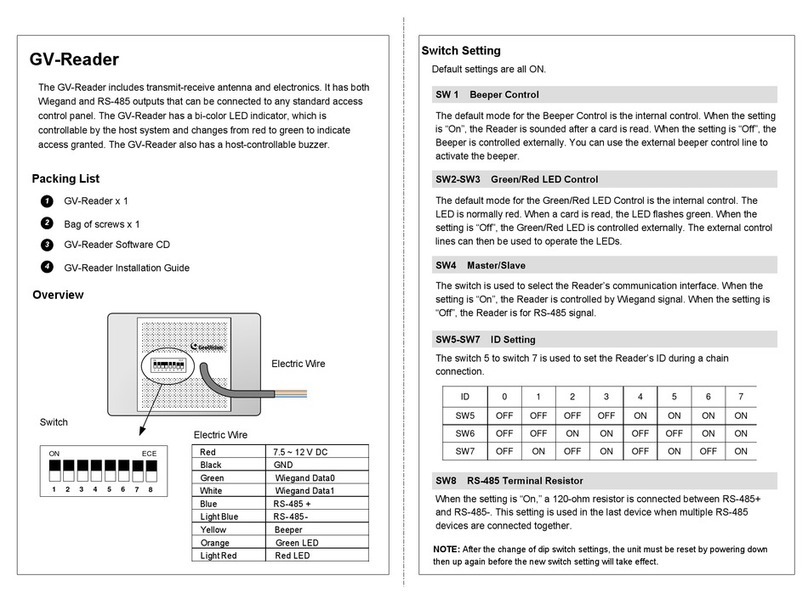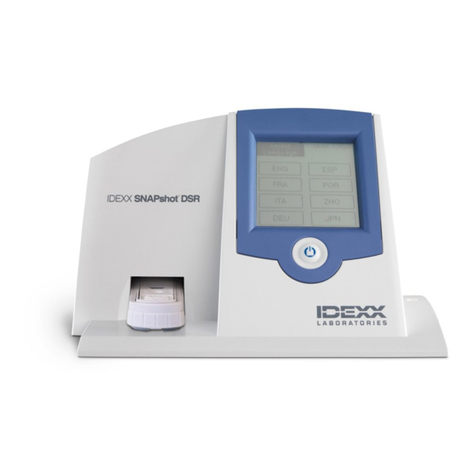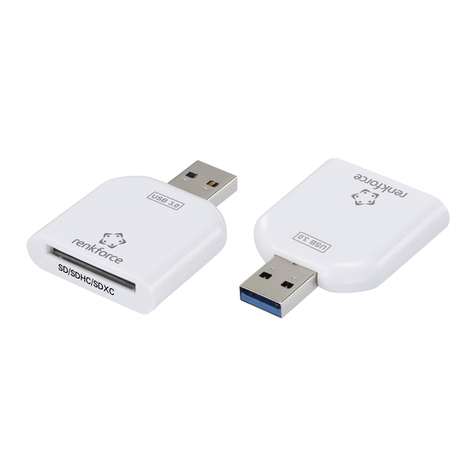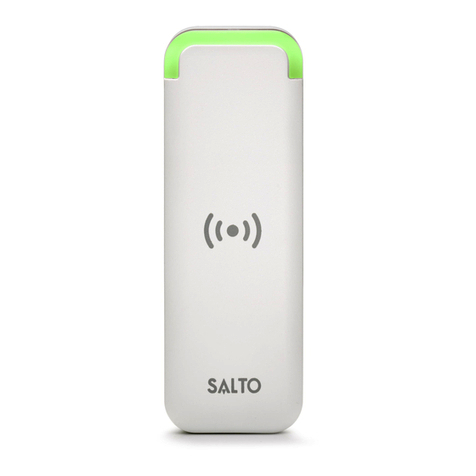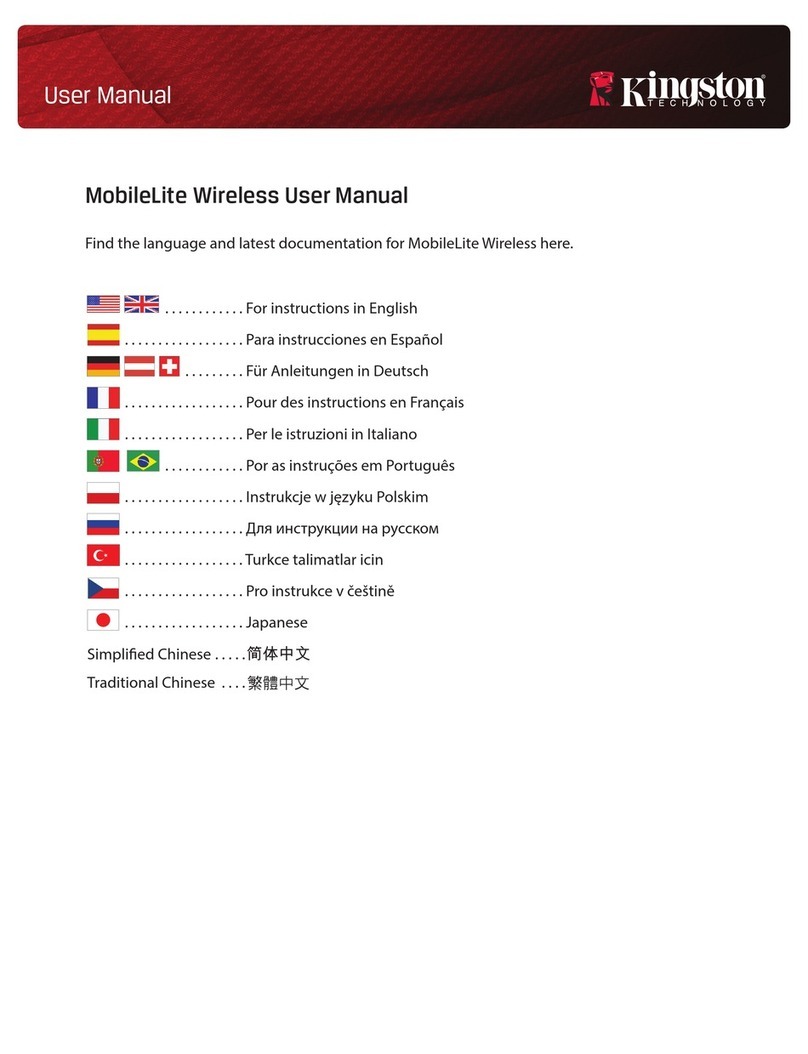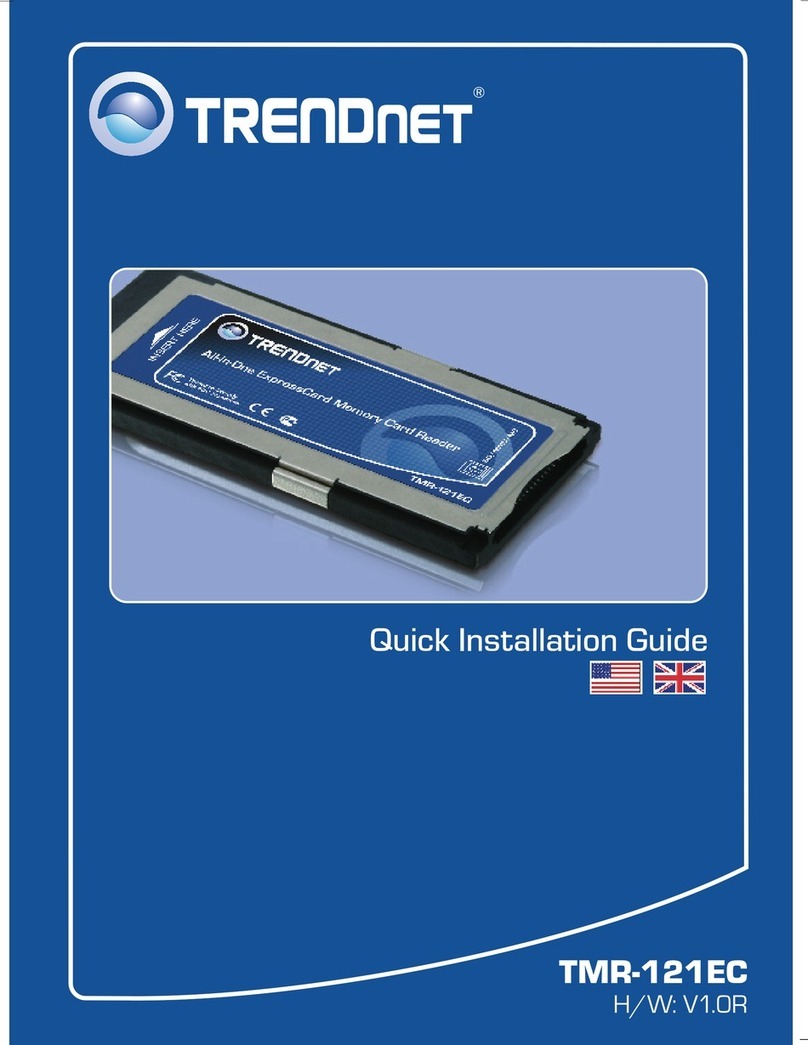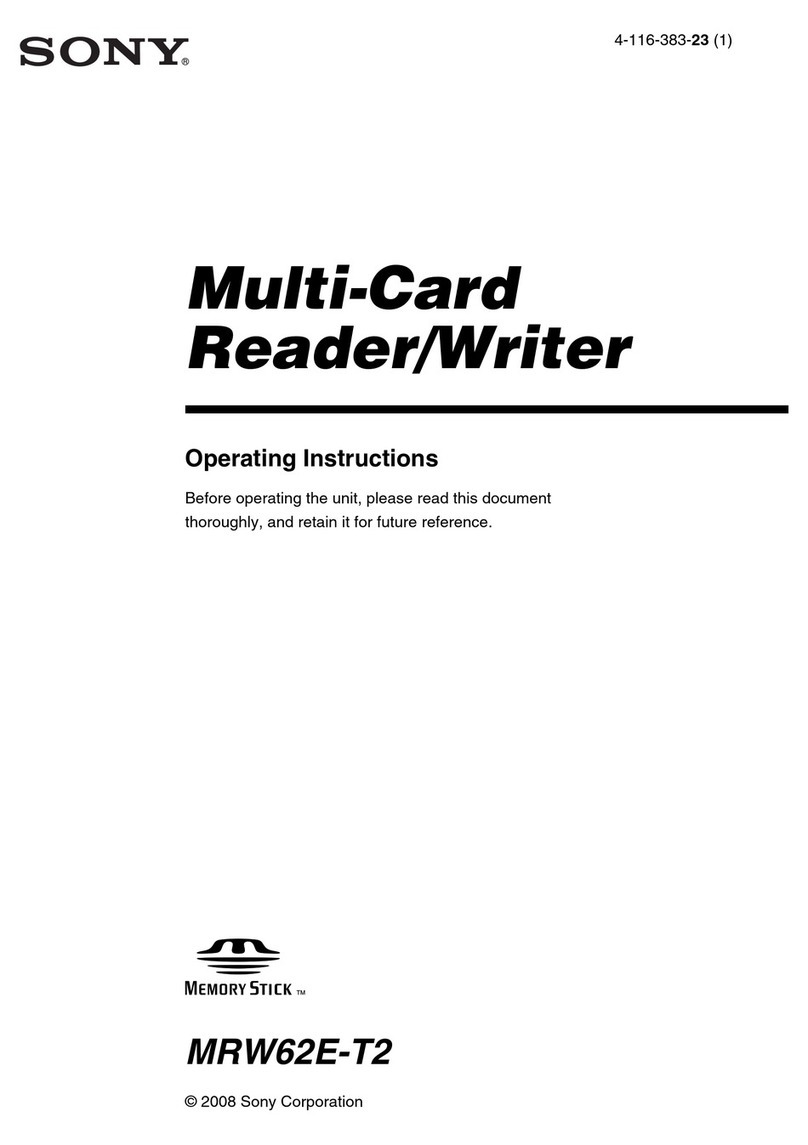Technology Solutions 1153 User manual

USER GUIDE:
1153 WEARABLE
BLUETOOTH
®UHF
RFID READER
www.tsl.uk.com
Design • Development • Manufacture

1153 UHF Reader User Guide V1.24
© Technology Solutions (UK) Ltd 2014 2
TERMS & CONDITIONS
© 2014 TSL. All rights reserved.
No part of this publication may be reproduced or used in any form, or by any electrical or mechanical means,
without permission in writing from Technology Solutions (UK) Ltd. This includes electronic or mechanical means,
such as photocopying, recording, or information storage and retrieval systems. The material in this manual is
subject to change without notice.
Technology Solutions (UK) Ltd (TSL) reserves the right to make changes to any product to improve reliability,
function, or design. TSL does not assume any product liability arising out of, or in connection with, the application
or use of any product, circuit, or application described herein. No license is granted, either expressly or by
implication, estoppel, or otherwise under any patent right or patent, covering or relating to any combination,
system, apparatus, machine, material, method, or process in which TSL products might be used. An implied
license exists only for equipment, circuits, and subsystems contained in TSL products. TSL and the TSL logo are
registered trademarks of TSL. Other product names mentioned in this manual may be trademarks or registered
trademarks of their respective companies and are hereby acknowledged.
All software is provided strictly on an “as is” basis. All software, including firmware, furnished to the user is on
a licensed basis. TSL grants to the user a non-transferable and non-exclusive license to use each software or
firmware program delivered hereunder (licensed program). Except as noted below, such license may not be
assigned, sublicensed, or otherwise transferred by the user without prior written consent of TSL. No right to
copy a licensed program in whole or in part is granted, except as permitted under copyright law. The user shall
not modify, merge, or incorporate any form or portion of a licensed program with other program material, create
a derivative work from a licensed program, or use a licensed program in a network without written permission
from TSL. The user agrees to maintain TSL’s copyright notice on the licensed programs delivered hereunder, and
to include the same on any authorized copies it makes, in whole or in part. The user agrees not to decompile,
disassemble, decode, or reverse engineer any licensed program delivered to the user or any portion thereof.
TSL reserves the right to make changes to any software or product to improve reliability, function, or design.
TSL does not assume any product liability arising out of, or in connection with, the application or use of any
product, circuit, or application described herein.
iPad, iPhone, iPod, iPod classic, iPod nano, iPod shuffle, and iPod touch are trademarks of Apple Inc., registered
in the U.S. and other countries. iOS is a registered trademark of Apple Inc.
“Made for iPod,” “Made for iPhone,” and “Made for iPad” mean that an electronic accessory has been designed
to connect specifically to iPod, iPhone, or iPad, respectively, and has been certified by the developer to meet
Apple performance standards. Apple is not responsible for the operation of this device or its compliance with
safety and regulatory standards. Please note that the use of this accessory with iPod, iPhone, or iPad may affect
wireless performance.
The
Bluetooth
®word mark and logos are registered trademarks owned by Bluetooth SIG, Inc. and any use of
such marks by Technology Solutions (UK) Ltd is under license. Other trademarks and trade names are those of
their respective owners.
www.tsl.uk.com

1153 UHF Reader User Guide V1.24
© Technology Solutions (UK) Ltd 2014 3
History
Version Date Modifications
1.0 05/08/2014 Document creation
1.1 28/08/2014 iOS 5/6 sections removed and replaced with iOS7
1.2 30/09/2014 iOS compatibility list updated
1.22 17/10/2014 Regulatory information updated
1.23 27/10/2014 Regulatory information updated
1.24 20/11/2014 Screenshot outlines added
CONTENT
Introduction 4
Parts of the 1153 UHF Reader 4
Using the 1153 UHF Reader 5
Battery Installation or Removal 5
Locking the Battery Cover (Optional) 9
Charging and Micro USB Connection 10
Connecting the Micro USB cable 10
Button Operation 11
Primary button action 11
Secondary Button action 11
Reading Transponders 12
Status LED 13
Connections 14
Bluetooth
®wireless technology connection 14
Compatible Apple product models 14
Other compatible products 14
Setting up a
Bluetooth
®connection with an Apple product 14
View list of
Bluetooth
®Devices (iOS 7) 15
Pair with TSL
Bluetooth
®device 16
Micro SD Card 20
Location and Installation 20
Auto Run File (AUTO.TXT) 21
Log File (LOG.TXT) 21
Software Development 22
Troubleshooting and Maintenance 23
Maintenance 23
Troubleshooting 23
Regulatory information 24
Information to the user – FCC 24
RF Exposure Guidelines 24
Laser Warning 24
Health and Safety Recommendations 25
Waste Electrical and Electronic Equipment (wEEE) 26
Warranty 26
About TSL 28
About 28
Contact 28
www.tsl.uk.com

1153 UHF Reader User Guide V1.24
© Technology Solutions (UK) Ltd 2014 4
Technology Solutions’ 1153 UHF Reader provides Ultra High Frequency (UHF) Radio Frequency Identification
(RFID), with optional barcode scanning functionality. The unit can be used stand alone or paired with a
Bluetooth
®
wireless technology enabled host device. It can be used with UHF transponders including the EPC Global Class 1
Generation 2 transponders.
INTRODUCTION
PARTS OF THE 1153 UHF READER
Micro USB connector
Status LEDs Trigger Button
UHF Antenna
FIGURE 1: Parts of the 1153 UHF Reader
WARNING
LASER LIGHT.
DO NOT STARE INTO BEAM.
CLASS 2 LASER
PRODUCT.
LASERSTRAHLUNG
NICHT IN DEN STRAHL BLICKEN.
LASER KLASSE 2.
LUMIÈRE
LASER NE PAS REGARDER
DANS LE FAISCEAU. APPAREIL
À LASER DE CLASSE 2.
630-670nm 1mW
www.tsl.uk.com

1153 UHF Reader User Guide V1.24
© Technology Solutions (UK) Ltd 2014 5
USING THE 1153 UHF READER
BATTERY INSTALLATION OR REMOVAL
The battery is charged using the supplied micro USB lead and therefore is unlikely to need to be changed once
installed. To access the battery compartment a slider switch must be moved. The battery compartment cover has
a release latch. To access the battery compartment, move the battery cover release slider to the position shown in
the diagram below.
FIGURE 3: Battery cover release slider in unlocked position
FIGURE 2: Battery cover release slider in locked position
‘Unlocked’ warning label
Battery cover
release slider
www.tsl.uk.com

1153 UHF Reader User Guide V1.24
© Technology Solutions (UK) Ltd 2014 6
USING THE 1153 UHF READER
FIGURE 5: Remove battery cover in this direction
FIGURE 4: Removeable battery cover
Once the battery cover release slider has been moved to the unlocked position, the battery cover can be removed
by simply pulling away from the 1153 body:
www.tsl.uk.com

1153 UHF Reader User Guide V1.24
© Technology Solutions (UK) Ltd 2014 7
USING THE 1153 UHF READER
The battery contacts need to be face down at the top of the battery to meet the contacts shown in the image below.
Battery contacts
FIGURE 6: Battery placement
FIGURE 7: Battery in position
www.tsl.uk.com

1153 UHF Reader User Guide V1.24
© Technology Solutions (UK) Ltd 2014 8
FIGURE 8: Replace battery cover
USING THE 1153 UHF READER
Once the battery is installed the actions to replace the cover are:
●Align the top edge of battery cover with the 1153 body
●Push the battery cover down into position
●Slide the locking switch into position
FIGURE 9: Move battery cover release slider to locked position
www.tsl.uk.com

1153 UHF Reader User Guide V1.24
© Technology Solutions (UK) Ltd 2014 9
USING THE 1153 UHF READER
LOCKING THE BATTERY COVER (OPTIONAL)
The battery cover can be locked into position using two M1.6x6mm Torx pan head screws.
M1.6x6mm Torx pan head screw.
FIGURE 10: Battery cover locking screw location
FIGURE 11: Battery cover fully locked
www.tsl.uk.com

1153 UHF Reader User Guide V1.24
© Technology Solutions (UK) Ltd 2014 10
USING THE 1153 UHF READER
CHARGING AND MICRO USB CONNECTION
CONNECTING THE MICRO USB CABLE
The 1153 UHF Reader kit is supplied with a micro USB lead for charging and synchronisation. A USB PSU is also
supplied for independent charging of the 1153 UHF Reader. The Micro USB connector is inserted into the 1153
UHF Reader as shown below.
FIGURE 13: Attaching the Micro USB cable
FIGURE 12: Location of Micro USB socket
www.tsl.uk.com

1153 UHF Reader User Guide V1.24
© Technology Solutions (UK) Ltd 2014 11
USING THE 1153 UHF READER
Primary button
(UHF transponder read)
Secondary button
(Barcode scan)
FIGURE 14: Location of Primary and Secondary Buttons
BUTTON OPERATION
The 1153 UHF Reader has a Primary button action and a Secondary button action, which can be initiated by
pressing the Primary or Secondary buttons on the top of the 1153 UHF Reader. By default, the Primary button
action scans for UHF transponders, whilst the Secondary button action initiates the laser barcode scanner (requires
2D Imager). The button actions are also programmable for custom applications.
PRIMARY BUTTON ACTION
- UHF Transponder Read
In the default configuration the 1153 UHF Reader scans for UHF transponders as the primary button action. The
1153 UHF Reader will continue to scan for UHF transponders whilst the primary button is pressed. It will stop
scanning once the button is released (and the current operation completes).
SECONDARY BUTTON ACTION
– Barcode Scan (requires 2D Imager)
In the default configuration the 1153 UHF Reader scans for barcodes as the secondary button action. The 1153
UHF Reader will continue to scan for a barcode while the button is pressed. It will stop scanning when any of the
following conditions are met:
●A barcode is scanned.
●The button is released.
●The barcode engine times out.
In the default configuration, the secondary button action (Barcode scanning) can also be initiated by a rapid
double-click-and-hold on the primary button.
www.tsl.uk.com

1153 UHF Reader User Guide V1.24
© Technology Solutions (UK) Ltd 2014 12
USING THE 1153 UHF READER
READING TRANSPONDERS
RFID transponders can be read when they are in range of the antenna. The antenna is located on the front of the
1153 UHF Reader. The range at which a transponder can be read depends on the transponder type and size, and
the number of transponders in the field.
FIGURE 15: Antenna read direction
The UHF reader reads
transponders in front
of the antenna
www.tsl.uk.com

1153 UHF Reader User Guide V1.24
© Technology Solutions (UK) Ltd 2014 13
STATUS LED
The status LEDs on the top of the 1153 UHF Reader provides an indication of the operating status of the 1153
UHF Reader.
LED Status
Blue slow flash (50% on, 50% off) The reader is awake but there is no connection
Blue constant The reader is awake and connected to a host
Short green flash The reader has successfully read a tag or barcode or executed
the alert command
Orange slow flash (50% on, 50% off) Battery low warning (<10% capacity remaining), please recharge
immediately
Orange short single slow flash Battery charging with battery level less than 33%
Orange short double flash Battery charging with battery level less than or equal to 66%
Orange short triple flash Battery charging with battery level greater than 66%
Orange rapid flash There is a charge error / battery fault
Orange constant The reader is fully charged
All off The reader is off and not charging
USING THE 1153 UHF READER
Charge statusRead indicator
Bluetooth
®status
FIGURE 16: Location of status LEDs
www.tsl.uk.com

1153 UHF Reader User Guide V1.24
© Technology Solutions (UK) Ltd 2014 14
BLUETOOTH
®WIRELESS TECHNOLOGY CONNECTION
COMPATIBLE APPLE PRODUCT MODELS
OTHER COMPATIBLE PRODUCTS
SETTING UP A
BLUETOOTH
®CONNECTION WITH AN APPLE PRODUCT
The 1153
Bluetooth
®Handheld UHF RFID Reader is compatible with many other
Bluetooth
®wireless technology
enabled host devices including Android, Windows CE, Windows Mobile 5/6.1/6.5 and Windows XP/Vista/7/8.
Awaken the 1153 UHF Reader by squeezing the trigger, which is confirmed by the flashing of the blue LED. To pair
with your iOS device, navigate to the
Bluetooth
®option within the Settings menu on your iOS device.
CONNECTIONS
The connection to the 1153 is either via Bluetooth or USB. Bluetooth connections use either a Virtual Com Port
(VCP) or via the iAP protocol for Apple devices. Over USB only VCP is available.
For VCP the connection is established at 115200 baud, 8 data bits, no parity, 1 stop bit and RTS/CTS (hardware)
flow control.
www.tsl.uk.com

1153 UHF Reader User Guide V1.24
© Technology Solutions (UK) Ltd 2014 15
VIEW LIST OF
BLUETOOTH
®DEVICES (iOS 7)
BLUETOOTH
®WIRELESS TECHNOLOGY CONNECTION
iPad®:
●Go to the Settings App.
FIGURE 19: Select
Bluetooth
®settings
FIGURE 20: List of devices in
Bluetooth
®settings
●Go to the Settings App.
●Select the
Bluetooth
®settings in the left hand
column.
FIGURE 18: List of devices in
Bluetooth
®settings
iPod®/ iPhone®:
●Tap on the
Bluetooth
®row to be taken to the
Bluetooth
®settings
www.tsl.uk.com

1153 UHF Reader User Guide V1.24
© Technology Solutions (UK) Ltd 2014 16
iPod®/ iPhone®
iPad®
FIGURE 21: Identify device
After successfully pairing with the 1153 UHF Reader the device will be shown as ‘connected’.
iPod®/ iPhone®
FIGURE 22: Device connected
iPad®
Open TSL’s RFID Explorer App.
The RFID Explorer App can be downloaded from the App Store.
PAIR WITH TSL
BLUETOOTH
®DEVICE
BLUETOOTH
®WIRELESS TECHNOLOGY CONNECTION
In the list of
Bluetooth
®devices, the 1153 UHF reader will be identified by its serial number (xxxxxx-xx-1153). Click
on the corresponding row to pair with the reader.
If RFID Explorer is installed on your device then a prompt will appear requesting a connection to the newly added
reader. Choose ‘Allow’ to launch RFID Explorer or ‘Ignore’ if the device is to be used with a different App.
iPod®/ iPhone®
FIGURE 23: Allow connection
iPad®
www.tsl.uk.com

1153 UHF Reader User Guide V1.24
© Technology Solutions (UK) Ltd 2014 17
BLUETOOTH
®WIRELESS TECHNOLOGY CONNECTION
If the app is starting up for the first time, no reader will be selected. To select a reader, tap on ‘Change Reader’ in
the menu to the left (iPad®) or ‘Paired Readers’ (iPod®/iPhone®).
iPod®/ iPhone®
iPad®
FIGURE 24: TSL RFID explorer App on first load - no reader selected
If you have a reader selected from your device’s
Bluetooth
®settings as previously shown, continue from Figure 28.
If the ‘No devices are available’ message in Figure 25 appears, you can also connect to a device through the RFID
Explorer app. Press the + sign presented in the top right corner of the Select Reader section/screen.
iPod®/ iPhone®
iPad®
FIGURE 25: No devices are available
www.tsl.uk.com

1153 UHF Reader User Guide V1.24
© Technology Solutions (UK) Ltd 2014 18
BLUETOOTH
®WIRELESS TECHNOLOGY CONNECTION
iPod®/ iPhone®
iPad®
FIGURE 26: Select the Reader to use
This will open a ‘Select An Accessory’ dialog box.
There may be a small delay in loading available readers.
Once the available readers have loaded select the 1153 UHF reader.
A list of compatible and currently paired
Bluetooth
® devices will appear. Select the device to be used with the RFID
Explorer App.
iPod®/ iPhone®
iPad®
FIGURE 27: List of paired
Bluetooth
®devices
www.tsl.uk.com

1153 UHF Reader User Guide V1.24
© Technology Solutions (UK) Ltd 2014 19
The selected device’s image will appear, accompanied by relevant device information. The ‘Inventory’, ‘Read/
Write’, ‘Commands’ and ‘Find a Tag’ features can now be explored. To maximise battery life it is recommended to
release the 1153 UHF Reader from its
Bluetooth
®connection if the reader is not to be used for a significant period
of time.
BLUETOOTH
®WIRELESS TECHNOLOGY CONNECTION
iPod®/ iPhone®
iPad®
FIGURE 28: 1153 UHF Reader selected and ready to use
www.tsl.uk.com

1153 UHF Reader User Guide V1.24
© Technology Solutions (UK) Ltd 2014 20
MICRO SD CARD
LOCATION AND INSTALLATION
A Micro SD card can be installed in to the 1153 reader. The card should be SD/SDHC compatible, FAT16 or FAT32
up to 32 GB. The MicroSD card slot is located inside the battery compartment.
FIGURE 13: Rotate card slot downwards FIGURE 13: Slide card slot into locked position
FIGURE 13: Insert MicroSD into card slot FIGURE 13: MicroSD inserted correctly
FIGURE 13: Slide card slot into unlocked position FIGURE 13: Rotate card slot outwards
www.tsl.uk.com
Table of contents
Other Technology Solutions Card Reader manuals
